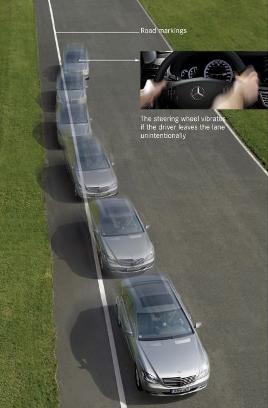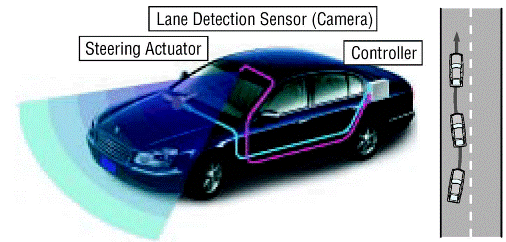
|
School of Engineering and Computer Science ECE-576 LANE DETECTION AND TRACKING By PhIlipp Czeschka Christian Kobel Maher Youkhana
|


|
The first production lane keeping assist system debuted on the Mercedes-Benz Actros commercial truck in Europe, in the late 1990s. In this case, the driver was warned of unintentional lane departures with the help of an audible that could be heard on the side of the vehicle drifting out of the lane. Obviously, in order for the system not to become utterly annoying each time the driver was switching lanes, if the correct turn signal was used, no warnings were generated.
In the early 2000s, a number of car manufacturers began introducing similar technologies on their models, from Citroen to Nissan, Honda, Toyota or BMW. Let's take a look at how some of them work: At some Nissan/Infiniti models, an onboard camera continuously monitors the lane markings on the road. If an unintended lane departure is observed, the system triggers a warning and/or gently applies brake pressure to the right or left wheels, according to which direction the vehicles is heading. It tries to both warn the driver and correct the vehicle's direction; Some Toyota and Lexus vehicles use a stereo camera system to monitor the lane markings on the road, thus having a better chance of observing if the car is drifting out of its lane. In case that happens, the electric steering pump will counter-steer the car back onto its lane. It tries to both warn the driver and correct the vehicle's direction; At Citroen, the lane assist system is not that intrusive and it monitors the lane markings on the road via infrared sensors. If an unintended lane departure is acknowledged, it will use a special vibration mechanism built into the seat to alert the driver. It only warns the driver without trying to correct the vehicle's direction;
At Mercedes-Benz, the newest generation of the lane keeping assist system is sort of a cross between the one found on certain Nissan/Infiniti models and Citroen. Using cameras to monitor the lane markings, if the aforementioned lane departure scenario happens it will first trigger a vibration mechanism built into the steering pump so it will vibrate the steering wheel, issue a visual and audible warning and then gently brake the wheels on the opposite side so as to automatically correct the vehicle's direction. All in all, as you can all imagine, neither of these systems is foolproof. They do help, a lot, in taking care of the direction you're going, but they're not all-knowledgeable. This technically means that having a car that can steer itself back into the driving lane, automatically brake and/or accelerate, doesn't mean that you can just set a course like Jean Luc Picard and take a nap while going a hundred miles an hour on the autobahn. Keep your eyes open and drive safe!
|
|
School of Engineering and Computer Science ECE-576 LANE DETECTION AND TRACKING By PhIlipp Czeschka Christian Kobel Maher Youkhana
|


